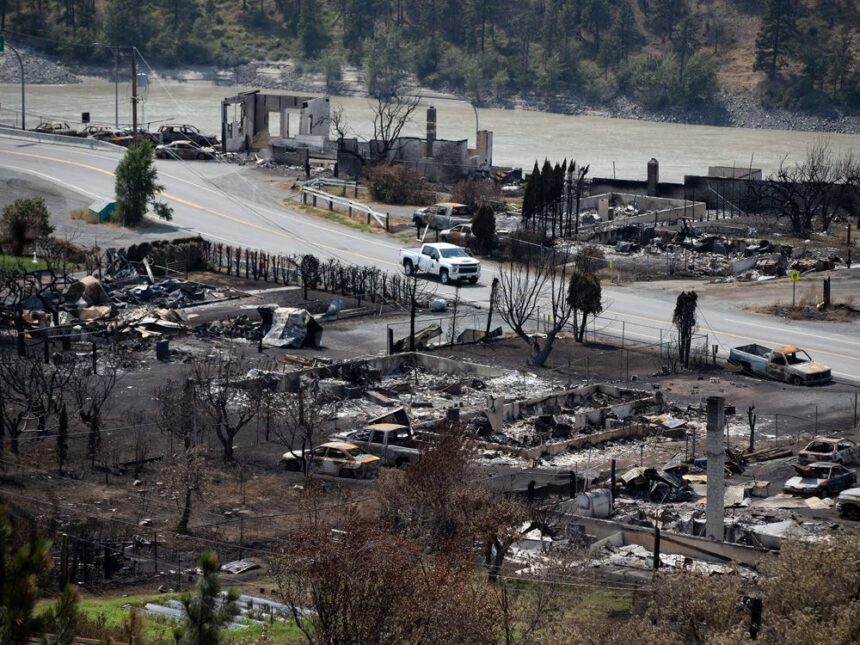The fiery nightmare that once again descended upon Lytton, British Columbia began with something surprisingly mundane – a wheel falling off an RCMP trailer. As the investigation confirms this unexpected origin story, residents of this Fraser Canyon community find themselves reliving trauma that many had barely begun to process.
Three years after a devastating wildfire destroyed most of Lytton, leaving residents to rebuild lives from ashes, Thursday’s evacuation order triggered by a new blaze has reopened wounds barely healed. According to Transportation Safety Board investigators, the fire originated when an RCMP trailer being towed along Highway 1 lost a wheel, causing sparks that ignited the bone-dry brush.
“The wheel assembly separated from the trailer and the resulting sparks from metal contacting the roadway surface ignited nearby combustible materials,” confirmed Chris Krepski, spokesperson for the Transportation Safety Board. The investigation continues into why mechanical failure on police equipment triggered such devastating consequences.
For Lytton Mayor Denise O’Connor, the findings represent a cruel twist. “Our community was just starting to see rebuilding progress after 2021,” she told me during a brief phone conversation from an evacuation center. “Some families had just received permits to return home. Now this happens because of equipment failure? It’s difficult to process.”
The BC Wildfire Service reports the blaze has grown to approximately 2,152 hectares as of Saturday morning, with about 200 properties under evacuation orders. Wind conditions and tinder-dry forests have complicated containment efforts, though no structures have been reported damaged thus far.
This incident raises uncomfortable questions about equipment maintenance standards for emergency vehicles. Former RCMP fleet manager Terry Davidson, now a safety consultant, points to systemic issues. “Police vehicles often operate under high stress conditions, but maintenance protocols should prevent catastrophic failures like wheels detaching during transport,” Davidson explained. “This warrants a full review of inspection procedures.”
For context, the 2021 Lytton wildfire destroyed approximately 90 percent of the village during an unprecedented heat dome that saw temperatures reach 49.6 Celsius – the hottest ever recorded in Canada. Two people died in that disaster, and rebuilding has progressed slowly, hampered by insurance challenges, labour shortages, and material costs.
Indigenous communities have been particularly impacted. Nlaka’pamux Nation Tribal Council chair Matt Pasco expressed frustration about the repeated trauma. “Our people were just regaining footing after the last disaster,” Pasco said. “Traditional lands scorched twice in three years represents not just physical damage but spiritual harm to territories our ancestors have stewarded for thousands of years.”
Climate scientists point to the incident as emblematic of British Columbia’s new reality. University of British Columbia forestry professor Dr. Lori Daniels notes, “The window for safe transportation through forested corridors is narrowing dramatically. What might have been a minor roadside incident a decade ago now carries catastrophic potential due to climate-driven conditions.”
Provincial data shows British Columbia experienced 82 percent more wildfires than the ten-year average by this point in 2023, with unusually early spring heat and minimal precipitation creating perfect fire conditions.
For evacuees sheltering in Lillooet and other nearby communities, the origins of the fire trigger complex emotions. “Knowing it started from something preventable makes it harder,” said Ron Killough, a Lytton resident who lost his home in 2021 and was evacuated again Thursday. “We understand accidents happen, but after everything we’ve been through, it’s hard not to ask if more precautions could have been taken.”
The RCMP has acknowledged the findings but declined detailed comment while investigation continues. “We are cooperating fully with transportation safety officials and will address any identified procedural issues,” stated Staff Sergeant Janelle Shoihet. “Our priority remains supporting evacuated communities and assisting emergency responders.”
As containment efforts continue, provincial response has mobilized significant resources. The BC Wildfire Service deployed 11 helicopters, multiple air tankers, and over 70 ground personnel. Highway 1 remains closed through the Fraser Canyon, disrupting a major transportation corridor.
Premier David Eby visited the emergency operations centre Saturday, pledging provincial support for affected communities. “We recognize the profound impact this has on a community still recovering from 2021,” Eby stated. “We’re committed to supporting Lytton through immediate response and longer-term recovery.”
For those tracking British Columbia’s escalating wildfire situation, the Lytton incident highlights the razor-thin margin between normal operations and disaster in our changing climate. What began with a mechanical failure on a highway has cascaded into a regional emergency – a sobering reminder of infrastructure vulnerabilities in an era of increased fire risk.
As evening fell over evacuation centres Saturday, residents gathered around news updates, sharing community information and supporting newcomers still arriving from outlying areas. The conversation inevitably turned to rebuilding – again. “Lytton people are resilient,” longtime resident Sarah McArthur reflected. “But there comes a point where you ask how many times a community can rise from ashes before something fundamental has to change.”






